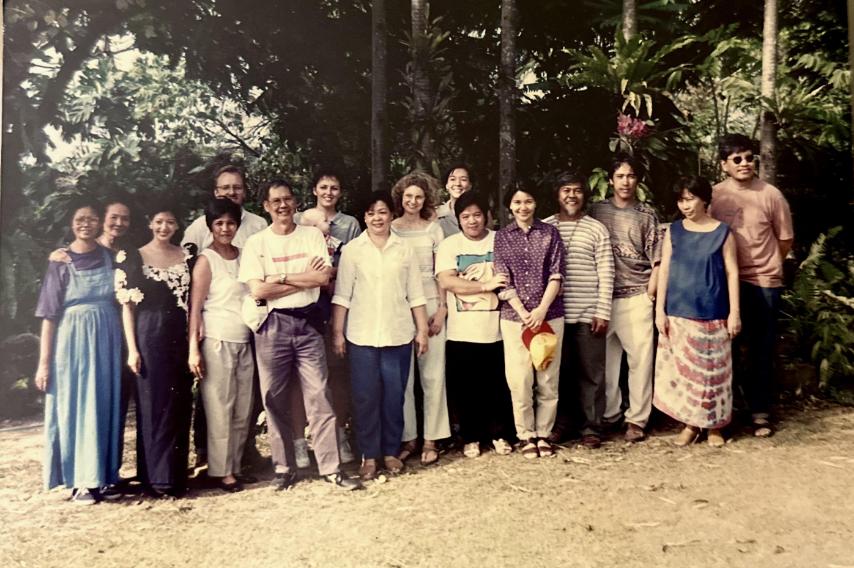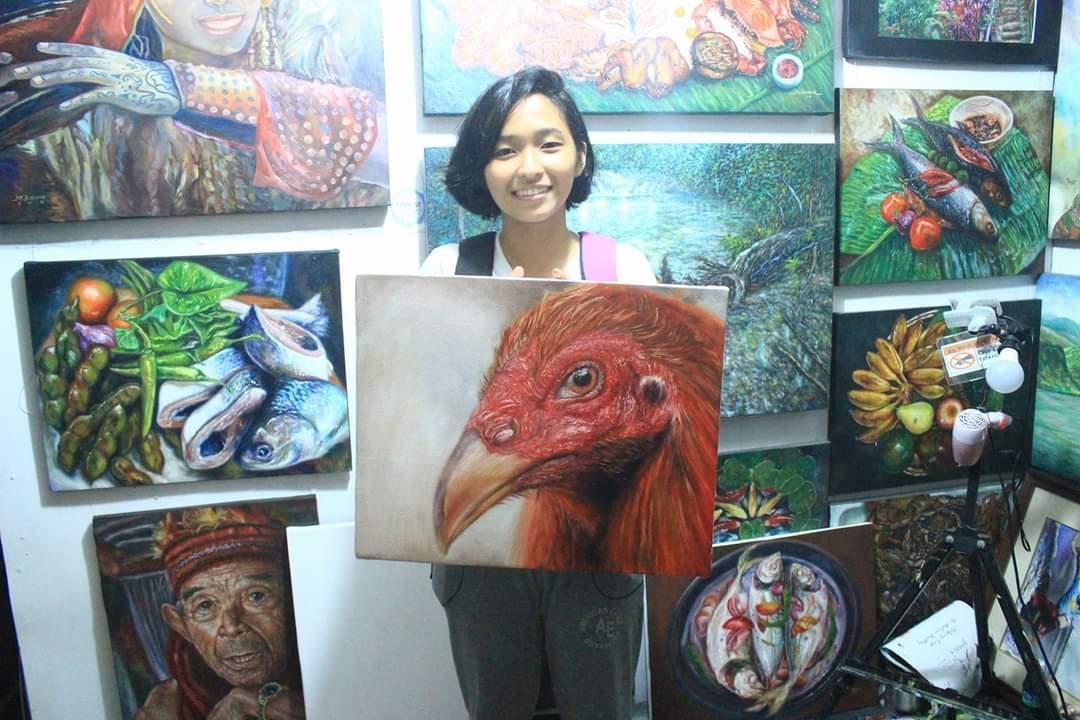Nestled amidst the Sierra Madre’s lush rain forests, watersheds, and nature reservations east of Metro Manila, the city of Antipolo, capitol of Rizal province, has for centuries been known as a Catholic pilgrimage site owing to the Antipolo Cathedral, recently declared a national shrine.
Despite other locales in Rizal and the nearby Laguna lake being traditionally known for art and craftsmanship, there is also a creative streak in the capitol—after all, places like Cloud Nine, the Crescent Moon Cafe, and Pinto Museum are some centers that have championed art since the 20th century. Come to think of it, art itself is embedded into and embodied by the Cathedral, which has also become a site of pilgrimage for fine arts students. Against this backdrop, two art collectives spanning generations emerged:, the original Antipolo Thursday Group (ATG) and its spiritual successor Artipolo.
It’s safe to bet that given more time and thanks to increasing institutional support, Antipolo can be another bustling Philippine art haven outside the Metro, like Baguio or Angono.
Homecoming to a second home
Tet Aligaen was reeling from a string of tragedies. After losing her daughter in 1996, she lost her husband in 2010. Suffice to say, her soul sought healing. Inday Cadapan, meanwhile, was in a faltering marriage, where the macho attitudes of the day informed her husband’s attitude. Cadapan was also struggling with chronic illnesses which one day took their toll.
One afternoon in 1996, Cadapan arrived home and exclaimed to daughter Magel, “I found my tribe!” Inday was referring to the Antipolo Thursday Group (ATG), which Tet had also joined, and which, as the name implies, was a weekly art-making gathering.
The styles developed through the years were as varied as a focus on portraiture, to impressionist to realist landscapes, to social realism, to pottery and ceramics. It was a space where people could choose a movement or medium and focus on it, fostered by the space.
A good number of members migrated to Antipolo, but something about the city made them decide to plant roots there.
That time, Magel was already a grown woman in a young marriage, she was helping her mother run their antique shop where they also sold art all while Inday worked to establish herself as an artist. “Finally,” she recalls thinking of her mother. “Her artist’s struggles would be validated.” Inday had often felt like “a square peg in a round hole.”
Many like Tet and Inday would find much-needed healing from the vagaries of life as well as an oasis in the form of a community of like-minded people dancing through life in a spirit of conviviality, all while encouraging each other in art-making.
It’s early October 2023, and I’m in a hotpot-grill joint in Antipolo. We’re celebrating the birthday of ATG member Angelita Lee. I initially get the healthier items, but cave in when I see that my Titos and Titas went crazy with the pork belly. “Don’t call me Tita,” one of them laughs, “first name is enough.” After honing her craft for years, Lee shares that she was “finally discovered in 2003.”
What was your goal when you started the group, I ask through a mouthful of ma la tang. To paint and eat, they quip, as member and newspaper owner Bambi Locsin lays more reams of cured beef on the grill. Many members have since passed on, but fondness accompanies each mention of their names.
When the group started in 1996, many members were already secure in their respective careers or otherwise established artists. Those who were just starting their art practice didn’t feel intimidated by more experienced practitioners. “The men weren’t macho,” a Tita recounts, “they were refined, respectful, affectionate.”
Group members would volunteer a house, and they would meet to paint there while the host prepared meals. The group became a habit and a home, and for many, the ATG was their form of therapy.
Veteran artists in the group such as Lino Severino, Alfredo Liongoren, and Antipas Delotavo never lorded it over their friends. Instead they openly shared both technical and practical art advice. Whatever criticism was levied was done so with kindness, with the intention to build on apparent strengths.

Aside from the aforementioned artists, the ATG also fostered the practice and launched the careers of Remy Boquiren, Didi Kabigting, Jeanne Tan, Robin Haines and Mark Merrill, Emma Gutierrez, Jun Macam, Jim Orencio, Susan Hassig, Brian Uhing, Pilar Clark, Andy Abu Urag, Maria Dinna Espina, Amor Quiñones, Sheila Tiangco, Lanelle Abueva, Isabel Maramba, and Pol Mesina.
After many years with the group, Mesina decided to create a similar space for younger artists from simpler backgrounds, and this would become Artipolo.
There’s something about working in an unhurried space full of banter that brings out the best in creative people. Life would eventually happen, and with it, challenges, but the members continually found a safe space in the ATG and its activities.
The birthday dinner comes to a close, and the waiter taking the group shot says they’re like teenagers, and he probably says this to every group of energetic veterans, but the Thursday Group, despite age, is not just youthful, but perhaps youth itself. “I found my soul group,” Locsin smiles as we part ways.
Wide doors, opened wider
“Coming from a blue collar background, I wanted people like me to also have time to make art, and more importantly, break into the art world,” Pol Mesina shares as he greets Lee, who asks if those in his table want a soup refill.
“More than half. I’d say 60% of the Artipolo members are students or working-class people,” shares Alexandra Monserrat, a board member from the group’s youth committee. We’re in a student-priced cafe on a busy street in Teacher’s Village across UP Diliman, a week after Lee’s birthday.
Joining us is Jessica Casaljay, Monserrat’s classmate and roommate who hails from Calbayog City in Samar. They study in UP and currently live in said Village. A native of Antipolo, Monserrat’s friendship with Casaljay eventually allowed the latter’s art group to exhibit with Artipolo.
Afterwards, Artipolo then exhibited in Calbayog as Casaljay hosted them. Casaljay co-leads Baghid, a collective of artists from her hometown mentored by Aris Ventura. Like the Titas of the ATG learning from the veteran members, Casaljay shares that veteran members of Artipolo such as Jun Vicaldo gave “helpful advice” as she explored new mediums.
“That really is Artipolo’s goal,” Monserrat clarifies, “to bring people together from different demographics through a shared interest in art.” Mesina, who co-mentors the group with Fernando Sena adds that Artipolo also wants to focus on giving back, taking on charity shows and often donating a majority of proceeds to children’s welfare.
In contrast to the ATG artists, who’ve largely stuck to their chosen themes, styles, and mediums, Artipolo is a drawing room for budding artists to find their voice. Monserrat shares that to master the foundations, many in the group are currently working on realism, which is their mentor Sena’s signature. Nonetheless, Mesina and the others encourage explorations, introducing media like clay here and there.
The ATG and Artipolo crowds have palpably different energy, and a competitive spirit is known to run among the members of the younger counterpart . Monserrat notes that with “more heads, there are more competing principles. But it’s interesting to see how art unites different types of people.”
Back in the hotpot place, Mesina mentions that “as long as the core members keep cool heads, it’s often that the understandable, forgivable flares of ego from younger artists will subside.” Artipolo isn’t just a group, it’s a harbor that launches – and guides – journeys through waters both calm and rough.
However, Monserrat emphasizes the role of individual initiative, observing that “it’s still up to the person on how they manage the opportunities that come their way. Not everyone takes the initiative. But if you do your part in the group, it will really open doors for you.” Echoing her friend, Casaljay recalls “the fact that they helped someone not from Antipolo. I’d say I also learned how to navigate the relationships in the art world.” She adds that “building connections with other artists, that’s how Artipolo helped me. They’d introduce young artists to experienced and well-known artists.”
It’s a weeklong academic break before their midterms, and I sense an undercurrent of stress in Monserrat and Casaljay. I spot paint drops on their fingernails and smell a whiff of canvas varnish. The work is hard, but something tells me in three weeks’ time, the party will be harder.
Aside from painting sessions, Artipolo goes on fieldtrips to museums or studios of veterans like Raul Isidro. Aside from regular mall shows such as Artablado in different Robinsons Malls, the group’s also mounted shows in Pinto Museum, the Crucible Gallery, and ManilArt. Mesina and Monserrat hope that as members grow in their careers and find new islands, they’ll look back to their Artipolo days and how they didn’t just grow as creatives but as people. While the ATG and Artipolo have different demographics composed of people at different stages in life, the common thread and commitment to fostering camaraderie is a welcome balm in an art scene increasingly shaped by market interests and competition.
Perhaps it’s time to schedule a pilgrimage (or move to?) to Antipolo for all the artsy reasons.
Follow Artipolo's activities on the official Instragam page, @artipolo_official. To stay up to date with all the arts and culture happenings in Antipolo, follow the official Facebook Page of the Antipolo Tourism Office here.
When Pao isn't writing about art, he's trying to be a cat-whisperer.

